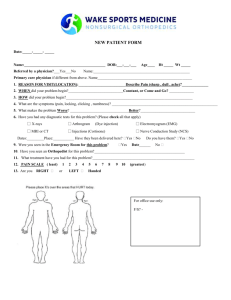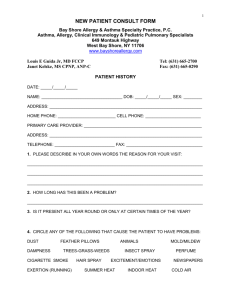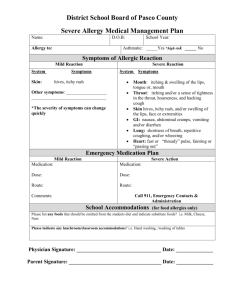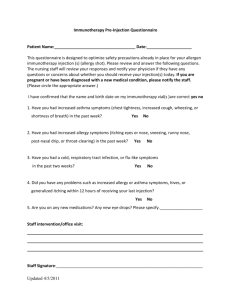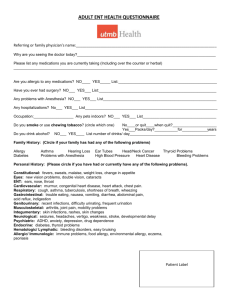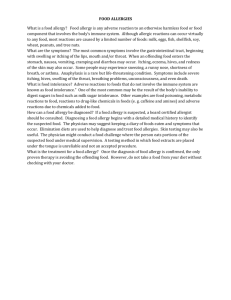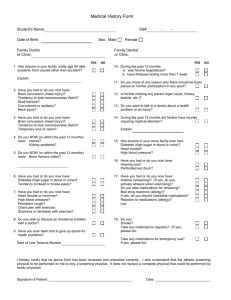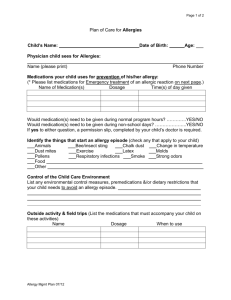itchiness_(pruritis)
advertisement
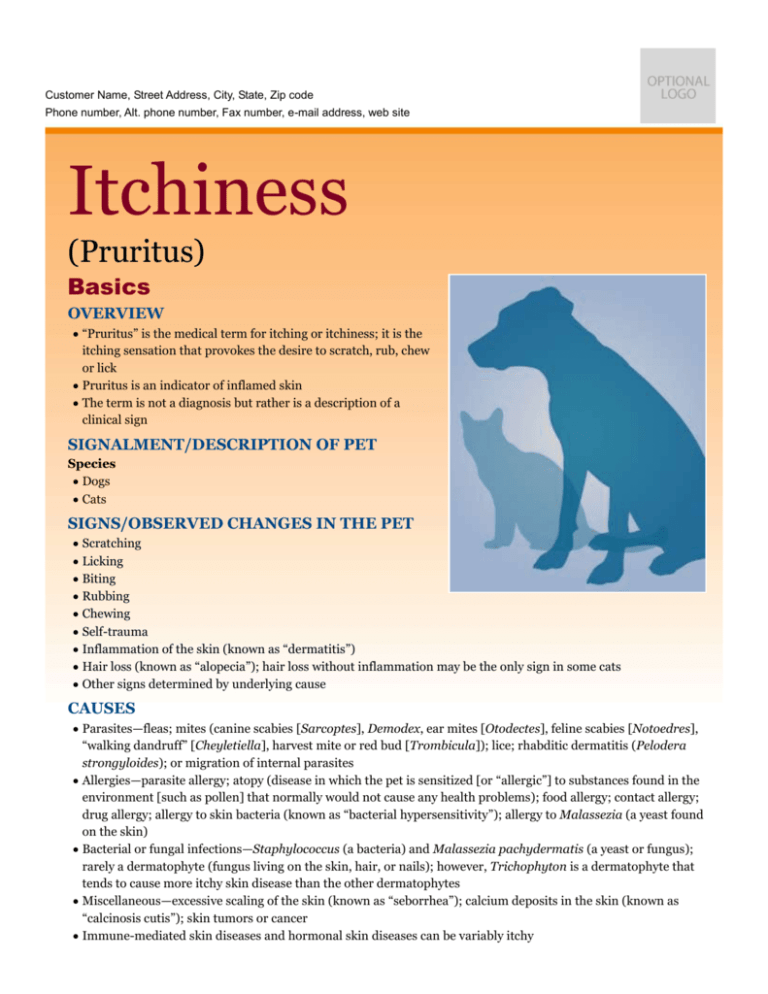
Customer Name, Street Address, City, State, Zip code Phone number, Alt. phone number, Fax number, e-mail address, web site Itchiness (Pruritus) Basics OVERVIEW • “Pruritus” is the medical term for itching or itchiness; it is the itching sensation that provokes the desire to scratch, rub, chew or lick • Pruritus is an indicator of inflamed skin • The term is not a diagnosis but rather is a description of a clinical sign SIGNALMENT/DESCRIPTION OF PET Species • Dogs • Cats SIGNS/OBSERVED CHANGES IN THE PET • Scratching • Licking • Biting • Rubbing • Chewing • Self-trauma • Inflammation of the skin (known as “dermatitis”) • Hair loss (known as “alopecia”); hair loss without inflammation may be the only sign in some cats • Other signs determined by underlying cause CAUSES • Parasites—fleas; mites (canine scabies [Sarcoptes], Demodex, ear mites [Otodectes], feline scabies [Notoedres], “walking dandruff” [Cheyletiella], harvest mite or red bud [Trombicula]); lice; rhabditic dermatitis (Pelodera strongyloides); or migration of internal parasites • Allergies—parasite allergy; atopy (disease in which the pet is sensitized [or “allergic”] to substances found in the environment [such as pollen] that normally would not cause any health problems); food allergy; contact allergy; drug allergy; allergy to skin bacteria (known as “bacterial hypersensitivity”); allergy to Malassezia (a yeast found on the skin) • Bacterial or fungal infections—Staphylococcus (a bacteria) and Malassezia pachydermatis (a yeast or fungus); rarely a dermatophyte (fungus living on the skin, hair, or nails); however, Trichophyton is a dermatophyte that tends to cause more itchy skin disease than the other dermatophytes • Miscellaneous—excessive scaling of the skin (known as “seborrhea”); calcium deposits in the skin (known as “calcinosis cutis”); skin tumors or cancer • Immune-mediated skin diseases and hormonal skin diseases can be variably itchy • Psychological skin diseases may be associated with itchiness RISK FACTORS • Exposure to other animals with parasites Treatment HEALTH CARE • More than one disease can contribute to itching • The use of mechanical restraint (such as an Elizabethan collar) can be a helpful option, but is seldom feasible in long-term treatment • Treat for secondary infections, which are common DIET • Depends on underlying cause • Usually no change in diet needed, unless suspect food allergy SURGERY • Skin biopsy may be necessary for diagnosis or to determine underlying cause Medications • Medications presented in this section are intended to provide general information about possible treatment. The treatment for a particular condition may evolve as medical advances are made; therefore, the medications should not be considered as all inclusive MEDICATIONS APPLIED TO THE SKIN DIRECTLY (KNOWN AS “TOPICAL THERAPY”) • Topical therapy is helpful in mildly itchy pets • For localized areas of itchiness or skin inflammation, sprays, lotions and creams are most appropriate • If the itching involves many areas or widespread areas, shampoos are the preferred means of application • Antibacterial shampoos help control bacterial infections that cause itching; however, some antibacterial shampoos (such as those containing benzoyl peroxide or iodine) can cause increased itching • Colloidal oatmeal is common in all forms of topical therapy; its duration of effect usually is less than two days • Topical antihistamines may be found alone or in combination with other ingredients; they may not have a beneficial effect • Topical anesthetics may offer only a very short duration of effect • Antimicrobial shampoos help control bacterial infections that cause itching; however, some contain ingredients (such as benzoyl peroxide or iodine) that can increase itchiness through excessive drying • Lime sulfur (which has a bad odor and can stain) can decrease itching, while also having anti-parasitic, antibacterial, and antifungal properties • Topical steroids probably are the most useful topical medications; hydrocortisone is the mildest and most common topical steroid; stronger steroids (such as betamethasone) may be more effective and are more expensive; a triamcinolone-containing prescription spray (Genesis® Topical Spray, Virbac) is effective in decreasing itchiness (pruritus) • Some topical steroid medications also contain ingredients (such as alcohol), which can aggravate already irritated skin • In some pets, the application of any substance, including water (especially warm water), can result in an increased level of itchiness; however, cool water often is soothing MEDICATIONS ADMINISTERED BY MOUTH OR BY INJECTION (SYSTEMIC THERAPY) • Steroids to decrease inflammation and itchiness of the skin • Cyclosporine to decrease the immune response • For pets affected with airborne allergies for more than a few months out of the year, “allergy shots” (known as “allergen specific immunotherapy”) are appropriate, frequently beneficial, and may lead to a cure (in some cases) • Antihistamines (such as hydroxyzine, diphenhydramine, and chlorpheniramine) to prevent inflammation and itching • Fatty acids are available in powders, liquids, and capsules; they help block pathways that lead to inflammation, but may require 6–8 weeks of use until maximum effect is observed; fatty acids work better as preventive medications, rather than stopping the inflammation once it has become a problem; they also help reduce dry or flaky skin, which can cause itching • Medications to relieve anxiety or depression (known as “psychogenic drugs”) can be helpful in controlling itchiness; include such drugs as amitriptyline, fluoxetine, and diazepam • In rare cases, alternative medications to decrease the immune response (known as “immunosuppressive drugs,” such as azathioprine) may be utilized; however, they should be reserved for instances when all other treatments have failed Follow-Up Care PATIENT MONITORING • Patient monitoring is imperative; pets should be examined periodically to evaluate response to treatment • Pets receiving long-term (chronic) medications should be evaluated every 3–12 months for potential side effects as well as occurrence of new contributing factors PREVENTIONS AND AVOIDANCE • Prevent infestation with parasites (such as fleas and mites) • Avoid foods identified as causing food allergy for your pet POSSIBLE COMPLICATIONS • Owner frustration is common • Complications (such as increased thirst [known as “polydipsia”] and increased urination [known as “polyuria”]) are common with long-term (chronic) steroid use EXPECTED COURSE AND PROGNOSIS • Depend on underlying cause • Many causes of itchiness in pets are extremely frustrating to control Key Points • Many different unrelated diseases may contribute to itchiness (pruritus), and control of one disease does not mean that other causes cannot be contributing to itchiness or cannot occur later • Multiple causes (such as flea allergy, inhalant allergy, and bacterial skin infection [known as “pyoderma”]) commonly are present in a single patient • Elimination of bacterial skin infection (pyoderma) and flea-associated disease may not be enough to significantly reduce itchiness • Food-allergy and inhalant-allergic pets may do well during the winter season with a hypoallergenic diet, only to become itchy during the warmer months in association with inhalant allergies Enter notes here Blackwell's Five-Minute Veterinary Consult: Canine and Feline, Fifth Edition, Larry P. Tilley and Francis W.K. Smith, Jr. © 2011 John Wiley & Sons, Inc.
